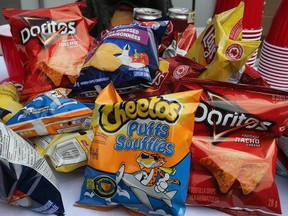
Article content
By Leia Minaker
Advertisement 2
Article content
In a grocery store recently, a friend’s young child gave a big hug to a brightly coloured, metre-high plastic cartoon mascot for a well-known candy brand that was standing at the end of an aisle surrounded by many bags of the candy on sale.
“Aww, that’s so cute!” was the mother’s first reaction.
Then it dawned on her — it wasn’t cute at all.
It was, she realized, very effective and invasive marketing. Not only did the youngster know and recognize the candy mascot, but she felt it was someone she should hug and that her mother should buy her some of that candy.
This was marketing of unhealthy foods to kids at its most basic, and it needs to stop.
The candy mascot set-up is an example of what are known as “island displays” in stores. Product manufacturers develop these free-standing displays — the more eye-catching the better — and will pay stores to use them so their product gets more attention and more of their product is sold.
Article content
Advertisement 3
Article content
Island displays are often used effectively to sell products that are on sale that week or for seasonal items, such as poinsettias at Christmas. The problem arises when they are used with compelling kid-appealing elements to promote unhealthy foods and sugary drinks — as they are far too often.
I recently released a report, funded by Heart & Stroke, about the marketing of food and beverages to kids, including tactics like island displays.
The report summarizes data my research group collected from grocery stores, corner stores and restaurants across 11 regions in Canada. The results show how pervasive island displays and other forms of marketing to kids really are.
On average, our research showed there were about 15 island displays per store, of which nine (almost 60 per cent) were child-directed. Of the island displays, 40 per cent used child themes or visual designs and 13 per cent had branded characters like the one my friend encountered.
Advertisement 4
Article content
Among retailers that had island displays, more than 90 per cent used them to sell unhealthy foods.
We found that marketing to kids is ubiquitous in grocery stores, corner stores and restaurants across Canada. In addition to island displays, marketers use myriad tactics like branded characters as well as child themes and designs on signage, posters and ice cream freezers to directly appeal to children.
This is a big problem because in-store marketing to kids works.
Junk food marketing leads to increased consumption of unhealthy foods and sugary drinks that contributes to our current dietary crisis — which is condemning many young people to a future of health challenges.
It rubs off on parents, too. Children influence the purchase of many foods for the whole family, often by pestering parents to buy the appealing, but unhealthy products they have seen advertised — not just in stores, but on TV and online.
Advertisement 5
Article content
Marketing of unhealthy food and sugary drinks needs to be reined in as part the federal government’s planned new regulations restricting marketing of such products to children under 13 years old.
The enactment of these restrictions is long overdue, but if marketing in grocery stores, convenience stores and restaurants is not included in the regulations, they will lose a large part of their effectiveness. If this loophole is left open it will be exploited by industry and lead to even greater amounts of point-of-sale marketing to kids.
We witnessed this when restrictions on tobacco advertising began — advertisers shifted their strategies to invest where they were still permitted. There is every reason to believe the same will happen for unhealthy foods and sugary drinks.
Marketing always evolves in response to policies that aim to curtail it by increasing efforts where it is not restricted. We urgently need the federal government to follow through on its commitment to introduce strong new regulations to restrict marketing to children.
And the regulations must include point-of-sale marketing that might look cute, but ultimately hurts our kids.
Leia Minaker is an associate professor in the School of Planning at the University of Waterloo. Her research includes the food environment, planning and health equity, nutrition and youth health.
Comments
Postmedia is committed to maintaining a lively but civil forum for discussion and encourage all readers to share their views on our articles. Comments may take up to an hour for moderation before appearing on the site. We ask you to keep your comments relevant and respectful. We have enabled email notifications—you will now receive an email if you receive a reply to your comment, there is an update to a comment thread you follow or if a user you follow comments. Visit our Community Guidelines for more information and details on how to adjust your email settings.
Join the Conversation